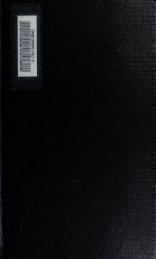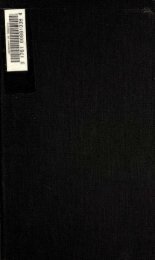Texts from the Buddhist canon : commonly known as Dhammapada
Texts from the Buddhist canon : commonly known as Dhammapada
Texts from the Buddhist canon : commonly known as Dhammapada
You also want an ePaper? Increase the reach of your titles
YUMPU automatically turns print PDFs into web optimized ePapers that Google loves.
!<br />
INTRODUCTION. 21<br />
379-<br />
Rouse thyself by thyself, examine thyself by thyself,<br />
thus self-protected and attentive wilt thou live happily,<br />
Bhikshu<br />
380.<br />
For self is <strong>the</strong> lord of self, self is <strong>the</strong> refuge of self;<br />
<strong>the</strong>refore curb thyself <strong>as</strong> <strong>the</strong> merchant curbs a good horse.<br />
381.<br />
The Bhikshu, full of delight, who is calm in <strong>the</strong> doc-<br />
trine of Buddha, will reach <strong>the</strong> quiet place (Nirv§,ma),<br />
cessation of natural desires, and happiness.<br />
382.<br />
He who, even <strong>as</strong> a young Bhikshu, applies himself to<br />
<strong>the</strong> doctrine of Bfiddha, brightens up this world, like <strong>the</strong><br />
moon when free <strong>from</strong> clouds.<br />
After looking through this extract, we cannot doubt <strong>the</strong><br />
fidelity of <strong>the</strong> Chinese version of <strong>Dhammapada</strong>,—and<br />
this section is only a fair sample of <strong>the</strong> whole.<br />
This also helps to clear <strong>the</strong> way to a fair estimate of <strong>the</strong><br />
value of Chinese <strong>Buddhist</strong> books generally.<br />
The English version which follows is not made <strong>from</strong><br />
<strong>the</strong> Text we have just considered, but <strong>from</strong> ano<strong>the</strong>r about<br />
which I now proceed to speak. The "Fa-kheu-pi-ii,"!<br />
—<br />
i.e. parables connected with <strong>the</strong> book of scriptural texts<br />
w<strong>as</strong> translated by two Shamans of <strong>the</strong> western Tsin<br />
dyn<strong>as</strong>ty (a.d. 265 to A.D. 313). As its name denotes, it<br />
contains certain parables, or tales, connected with <strong>the</strong> verses<br />
which follow <strong>the</strong>m, and which prompted <strong>the</strong>ir delivery.<br />
How far <strong>the</strong>se tales are genuine may be difficult to determine.<br />
Professor Max MiiRer h<strong>as</strong> already observed that<br />
^ In <strong>the</strong> " Chi-yuen-f3,-pao-kh^- (Dhammiipada), and it is explained<br />
tnng-tsung-lu," Kionen X. fol. 1, this<br />
work is quoted <strong>as</strong> " Fa-kheu-pen-mih<br />
in <strong>the</strong> margin that <strong>the</strong> verses are<br />
mere selections <strong>from</strong> <strong>the</strong> beginning<br />
king," i.e., "beginnings and endings and conclusion of <strong>the</strong> original work,<br />
<strong>from</strong> <strong>the</strong> book of scriptural tests"<br />
-





